Silk Road › Roman Games, Chariot Races & Spectacle › Ancient origins
Articles and Definitions › Contents
- Silk Road › Ancient History
- Roman Games, Chariot Races & Spectacle › Antique Origins
Ancient civilizations › Historical and archaeological sites
Silk Road › Ancient History
Definition and Origins
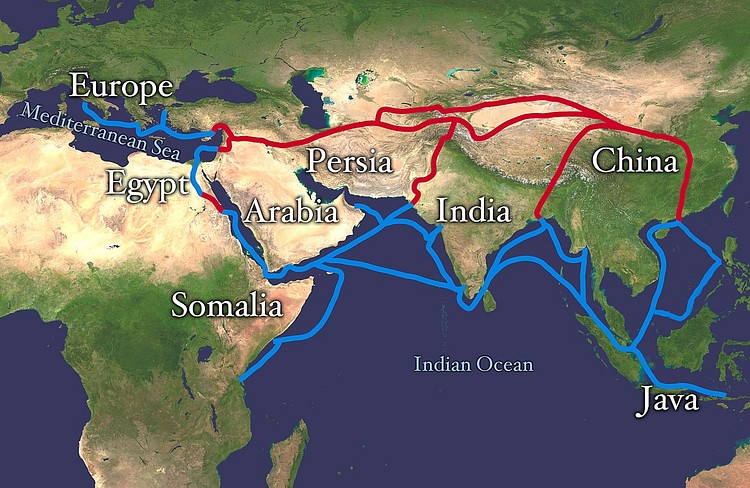
The Silk Road was an ancient network of trade routes, formally established during the Han Dynasty of China, which linked the regions of the ancient world in commerce between 130 BCE-1453 CE. As the Silk Road was not a single thoroughfare from east to west, the term 'Silk Routes' has become increasingly favored by historians, though 'Silk Road' is the more common and recognized name.
The European explorer Marco Polo (1254-1324 CE) traveled on these routes and described them in depth in his famous work but he is not credited with naming them. Both terms for this network of roads were coined by the German geographer and traveler, Ferdinand von Richthofen, in 1877 CE, who designated them 'Seidenstrasse' (silk road) or 'Seidenstrassen' (silk routes). Polo, and later von Richthofen, make mention of the goods which were transported back and forth on the Silk Road.
From West to East these goods included:
- Horses
- Saddles and Riding Tack
- The grapevine and grapes
- Dogs and other animals both exotic and domestic
- Animal furs and skins
- Honey
- Fruits
- Glassware
- Woolen blankets, rugs, carpets
- Textiles (such as curtains)
- Gold and Silver
- Camels
- Slaves
- Weapons and armor
From East to West the goods included:
- Silk
- Tea
- Dyes
- Precious Stones
- China (plates, bowls, cups, vases)
- Porcelain
- Spices (such as cinnamon and ginger)
- Bronze and gold artifacts
- Medicine
- Perfumes
- Ivory
- Rice
- Paper
- Gunpowder
The network was used regularly from 130 BCE, when the Han officially opened trade with the west, to 1453 CE, when the Ottoman Empire boycotted trade with the west and closed the routes. By this time, Europeans had become used to the goods from the east and, when the Silk Road closed, merchants needed to find new trade routes to meet the demand for these goods.
The closure of the Silk Road initiated the Age of Discovery (1453-1660 CE) which would be defined by European explorers taking to the sea and charting new water routes to replace over-land trade. The Age of Discovery would impact cultures around the world as European ships claimed some lands in the name of their god and country and influenced others by introducing western culture and religion and, at the same time, these other nations influenced European culture. The Silk Road - from its opening to its closure - had so great an impact on the development of world civilization that it is difficult to imagine the modern world without it.
PERSIAN ROYAL ROAD
The history of the Silk Road pre-dates the Han Dynasty in practice, however, as the Persian Royal Road, which would come to serve as one of the main arteries of the Silk Road, was established during the Achaemenid Empire (500-330 BCE). The Persian Royal Road ran from Susa, in north Persia (modern day Iran) to the Mediterranean Sea in Asia Minor (modern-day Turkey ) and featured postal stations along the route with fresh horses for envoys to quickly deliver messages throughout the empire. Herodotus, writing of the speed and efficiency of the Persian messengers, stated that:
There is nothing in the world that travels faster than these Persian couriers. Neither snow, nor rain, nor heat, nor darkness of night prevents these couriers from completing their designated stages with utmost speed. ( HistoriesVIII.98)
These lines would, centuries later, form the creed of the United States of America's post office. The Persians maintained the Royal Road carefully and, in time, expanded it through smaller side roads. These paths eventually crossed down into the Indian sub-continent, across Mesopotamia, and over into Egypt.
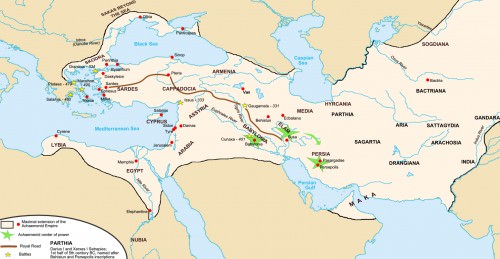
Persian Royal Road
CHINA & THE WEST
After Alexander the Great conquered the Persians, he established the city of Alexandria Eschate in 339 BCE in the Fergana Valley of Neb (modern Tajikistan). Leaving behind his wounded veterans in the city, Alexander moved on. In time, these Macedonian warriors intermarried with the indigenous populace creating the Greco-Bactrian culture which flourished under the Seleucid Empire following Alexander's death.
Under the Greco-Bactrian king Euthydemus I (260-195 BCE) the Greco-Bactrians had extended their holdings. According to the Greek historian Strabo (63-24 CE) the Greeks “extended their empire as far as the Seres” ( Geography XI.ii.i). `Seres' was the name by which the Greeks and Romans knew China, meaning `the land where silk came from'. It is thought, then, that the first contact between China and the west came around the year 200 BCE.
EMPEROR WU WAS EAGER TO GAIN NEW COMMODITIES THROUGH TRADE WITH THE WEST & THE SILK ROAD WAS OPENED IN 130 BCE.
The Han Dynasty of China (202 BCE – 220 CE) was regularly harassed by the nomadic tribes of the Xiongnu on their northern and western borders. In 138 BCE, Emperor Wu sent his emissary Zhang Qian to the west to negotiate with the Yuezhi people for help in defeating the Xiongnu.
Zhang Qian's expedition led him into contact with many different cultures and civilizations in central Asia and, among them, those whom he designated the `Dayuan', the `Great Ionians', who were the Greco-Bactrians descended from Alexander the Great's army. The Dayuan had mighty horses, Zhang Qian reported back to Wu, and these could be employed effectively against the marauding Xiongnu.
The consequences of Zhang Qian's journey was not only further contact between China and the west but an organized and efficient horse breeding program throughout the land in order to equip a cavalry. The horse had long been known in China and had been used in warfare for cavalry and chariots as early as the Shang Dynasty (1600 – 1046 BCE) but the Chinese admired the western horse for its size and speed. With the western horse of the Dayuan, the Han Dynasty defeated the Xiongnu. This success inspired Emperor Wu to speculate on what else might be gained through trade with the west and the Silk Road was opened in 130 BCE.
Between 171-138 BCE, Mithridates I of Parthia campaigned to expand and consolidate his kingdom in Mesopotamia. The Seleucid King Antiochus VII Sidetes (138-129 BCE) opposed this expansion and, also wishing revenge for the death of his brother, Demetrius, waged war against the Parthian forces of Phrates II, Mithridates successor. With the defeat of Antiochus, Mesopotamia came under Parthian rule and, with it, came control of the Silk Road. The Parthians then became the central intermediaries between China and the west.
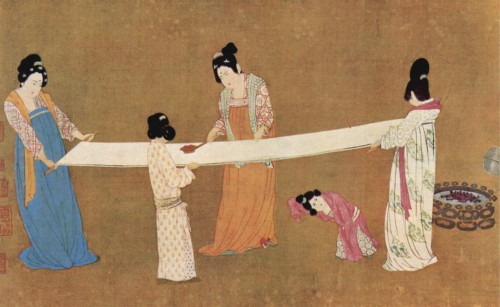
Women Checking Silk, Song China.
GOODS TRADED VIA THE SILK ROAD
While many different kinds of merchandise traveled along the Silk Road, the name comes from the popularity of Chinese silk with the west, especially with Rome. The Silk Road routes stretched from China through India, Asia Minor, up throughout Mesopotamia, to Egypt, the African continent, Greece, Rome, and Britain.
The northern Mesopotamian region (present-day Iran) became China's closest partner in trade, as part of the Parthian Empire, initiating important cultural exchanges. Paper, which had been invented by the Chinese during the Han Dynasty, and gunpowder, also a Chinese invention, had a much greater impact on culture than did silk. The rich spices of the east, also, contributed more than the fashion which grew up from the silk industry. Even so, by the time of the Roman EmperorAugustus (r.27 BCE – 14 CE) trade between China and the west was firmly established and silk was the most sought-after commodity in Egypt, Greece, and, especially, in Rome.
THE ROMAN LOVE OF SILK
Prior to becoming Emperor Augustus, Octavian Caesar seized on the controversial topic of silk clothing to denounce his adversaries Mark Antony (83-30 BCE) and Cleopatra VII (69-30 BCE) as immoral. As they both favored Chinese silk, which was increasingly becoming associated with licentiousness, Octavian exploited the link to deprecate his enemies. Octavian would triumph over Antony and Cleopatra ; he could do nothing, however, to curtail the popularity of silk.
The historian Will Durant writes:
The Romans thought [silk] a vegetable product combed from trees and valued it at its weight in gold. Much of this silk came to the island of Kos, where it was woven into dresses for the ladies of Rome and other cities ; in AD 91 the relatively poor state of Messenia had to forbid its women to wear transparent silk dresses at religious initiations. (329)
THE ISLAND OF KOS BECAME WEALTHY & LUXURIOUS THROUGH THEIR MANUFACTURE OF SILK CLOTHING.
By the time of Seneca the Younger (4 BCE – 65 CE), conservative Romans were more ardent than Augustus in decrying the Chinese silk as immoral dress for women and effeminate attire for men. These criticisms did nothing to stop the silk trade with Rome, however, and the island of Kos became wealthy and luxurious through their manufacture of silk clothing.
As Durant writes, " Italy enjoyed an 'unfavorable' balance of trade – cheerfully [buying] more than she sold” but still exported rich goods to China such as “carpets, jewels, amber, metals, dyes, drugs, and glass” (328-329). Up through the time of the emperor Marcus Aurelius (r.161-180 CE), silk was the most valued commodity in Rome and no amount of conservative criticism seemed to be able to slow the trade or stop the fashion.
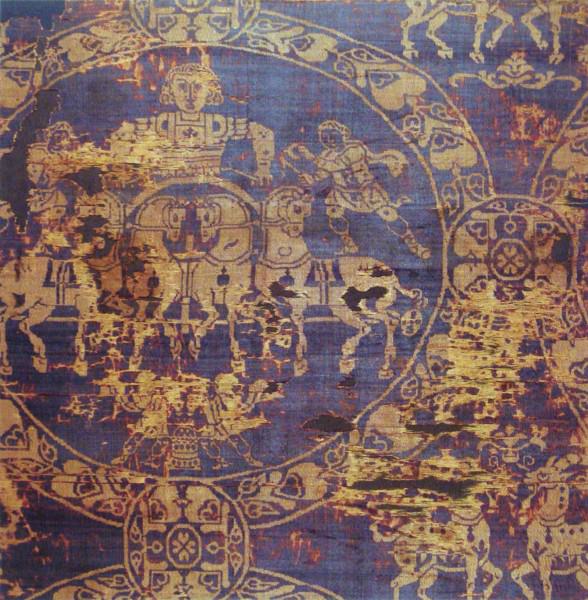
Tyrian Purple Shroud of Charlemagne
Even after Aurelius, silk remained popular, though increasingly expensive, until the fall of the Roman Empire in 476 CE. Rome was survived by its eastern half which came to be known as the Byzantine Empire and which carried on the Roman infatuation with silk. Around 60 CE the west had become aware that silk was not grown on the trees in China but was actually spun by silkworms. The Chinese had very purposefully kept the origin of silk a secret and, once it was out, carefully guarded their silkworms and their process of harvesting the silk.
The Byzantine emperor Justinian (527- 565 CE), tired of paying the exorbitant prices the Chinese demanded for silk, sent two emissaries, disguised as monks, to China to steal silkworms and smuggle them back to the west. The plan was successful and initiated the Byzantine silk industry. When the Byzantine Empire fell to the Turks in 1453 CE, the Ottoman Empire closed the Silk Road and cut all ties with the west.
THE SILK ROAD LEGACY
The greatest value of the Silk Road was the exchange of culture. Art, religion, philosophy, technology, language, science, architecture, and every other element of civilization was exchanged along these routes, carried with the commercial goods the merchants traded from country to country. Along this network disease traveled also, as evidenced in the spread of the bubonic plague of 542 CE which is thought to have arrived in Constantinople by way of the Silk Road and which decimated the Byzantine Empire.
The closing of the Silk Road forced merchants to take to the sea to ply their trade, thus initiating the Age of Discovery which led to world-wide interaction and the beginnings of a global community. In its time, the Silk Road served to broaden people's understanding of the world they lived in; its closure would propel Europeans across the ocean to explore, and eventually conquer, the so-called New World of the Americas. In this way, the Silk Road can be said to have established the groundwork for the development of the modern world.
Roman Games, Chariot Races & Spectacle › Antique Origins
Ancient Civilizations
If there was one thing the Roman people loved it was spectacle and the opportunity of escapism offered by weird and wonderful public shows which assaulted the senses and ratcheted up the emotions. Roman rulers knew this well and so to increase their popularity and prestige with the people they put on lavish and spectacular shows in purpose-built venues across the empire. Such famous venues as the Colosseum and Circus Maximus of Rome would host events involving magnificent processions, exotic animals, gladiator battles, chariot races, executions and even mock naval battles.
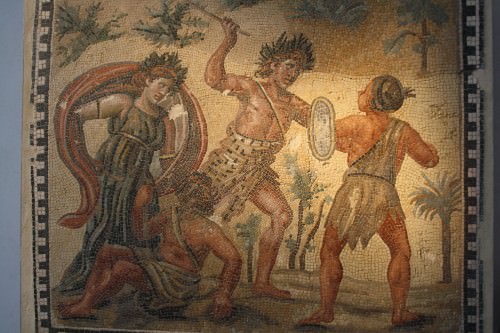
Roman Mosaic
VENUES
It is significant that most of the best-preserved buildings from the Roman period are those which were dedicated to entertainment. Amphitheatres and circuses were built across the empire and even army camps had their own arena. The largest amphitheatre was the Colosseum with a capacity of at least 50,000 (likely more, if one factors in the smaller bodies and different sense of personal space compared to modern standards) whilst the Circus Maximus could hold a massive 250,000 spectators according to Pliny the Elder. With so many events on such a large scale, spectacles became a huge source of employment, from horse trainers to animal trappers, musicians to sand rakers.
From the end of the republic seats in the theatre, arena and circus were divided by class. Augustus established further rules so that slaves and free persons, children and adults, rich and poor, soldiers and civilians, single and married men were all seated separately, as were men from women. Naturally, the front row and more comfortable seats were reserved for the local senatorial class. Tickets were probably free to most forms of spectacle as organisers, whether city magistrates given the responsibility of providing public civic events, super-rich citizens or the emperors who would later monopolise control of spectacles, were all keen to display their generosity rather than use the events as a source of revenue.

Circus Maximus, Rome
CHARIOT RACES
The most prestigious chariot races were held in Rome's Circus Maximus but by the 3rd century CE other major cities such as Antioch, Alexandria and Constantinople also had circuses with which to host these spectacular events, which became, if anything, even more popular in the later empire. Races at the Circus Maximus probably involved a maximum of twelve chariots organised into four factions or racing-stables - Blues, Greens, Reds, and Whites - which people followed with a passion similar to sports fans today. There was even the familiar hatred of opposing teams as indicated by lead curse tablets written against specific charioteers and certainly bets, both large and small, were placed on the races.
NERO EVEN RACED WITH A TEN-HORSE TEAM BUT CAME A CROPPER AS A RESULT & WAS THROWN FROM HIS CHARIOT.
Different types of chariot races could require more technical skill from the charioteers, such as races with teams of six or seven horses or using unyoked horses. Nero even raced with a ten-horse team but came a cropper as a result and was thrown from his chariot. There were races where charioteers raced in teams and the most anticipated races of all, those only for champions. Successful racers could become millionaires and one of the most famous was Gaius Appuleius Diocles who won an astonishing 1463 races in the 2nd century CE.
In the imperial period the circus also became the most likely place for a Roman to come into contact with their emperor and, therefore, rulers were not slow to use the occasions to strengthen their emotional and political grip on the people by putting on an unforgettable show.
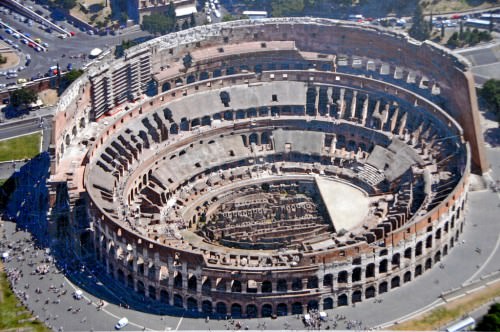
The Colosseum or Flavian Amphitheatre
GLADIATOR CONTESTS
Just as modern cinema audiences hope to escape the ordinariness of daily life, so too the crowd in the arena could witness weird, spectacular, and often bloody shows and become immersed, even lost, in the seemingly uncontrollable emotion of the arena. Qualities such as courage, fear, technical skill, celebrity, the past revisited, and, of course, life and death itself, engaged audiences like no other entertainment and no doubt one of the great appeals of gladiator events, as with modern professional sport, was the potential for upsets and underdogs to win the day.
The earliest gladiator contests ( munera ) date to the 4th century BCE around Paestum in southern Italy whilst the first in Rome itself are traditionally dated to 264 BCE, put on to honour the funeral of one Lucius Junius Brutus Pera. Eventually, arenas spread around the empire from Antioch to Gaul as rulers became ever more willing to show off their wealth and concern for the public's pleasure, In Rome city magistrates had to put on a gladiator show as the price for winning office and cities across the empire offered to host local contests to show their solidarity with the ways of Rome and to celebrate notable events such as an imperial visit or an emperor's birthday.
THERE WERE SLAVE GLADIATORS AS WELL AS FREED MEN & PROFESSIONALS, & FOR EXTRA SPECIAL OCCASIONS EVEN FEMALE GLADIATORS.
In the 1st century BCE schools were established to train professional gladiators, especially in Capua (70 BCE), and amphitheatres were also made into more permanent and imposing structures using stone. The events became so popular and grandiose that limits were put on just how many fighting pairs would participate in a show and how much money was allowed to be poured into them. Due to this expense and the additional hazard of fines for hiring a gladiator and not returning him in good condition, many gladiator contests now became less fatal for the participants and this strategy also served to add more drama to the public execution events where death was absolutely certain.
Some elite writers such as Plutarch and Dio Chrysostom protested that the gladiator contests were unbecoming and contrary to 'classical' cultural ideals. Even some emperors displayed little enthusiasm for the arena, the most famous case being Marcus Aurelius, who took his paperwork to the events. Whatever their personal tastes though, the shows were too popular to be stopped and it was only in later times that gladiator contests, at odds with the new Christian-minded Empire, declined under the Christian emperors and finally came to an end in 404 CE.

Roman Mosaic
WILD ANIMAL HUNTS
Besides gladiator contests, Roman arenas also hosted events using exotic animals ( venationes ) captured from far-flung parts of the empire. Animals could be made to fight each other or fight with humans. Animals were frequently chained together, often a duo of carnivore and herbivore and cajoled into fighting each other by the animal handlers ( bestiarii ) Certain animals acquired names and gained fame in their own right. Famous 'hunters' ( venatores ) included the emperors Commodus and Caracalla, although the risk to their person was no doubt minimal. The fact that such animals as panthers, lions, rhinos, hippopotamuses, and giraffes had never been seen before only added to the prestige of the organisers of these shows from another world.
TRIUMPHS, PROCESSIONS & NAVAL BATTLES
Triumphs celebrated military victories and usually involved a military parade through Rome which began at the Porta Triumphalis and, via a convoluted route, ended at the temple of Jupiter Optimus Maximus on the Capitol. The victorious general and a select group of his troops were accompanied by flag bearers, trumpeters, torch bearers, musicians and all of the magistrates and senators. The general or emperor, dressed as Jupiter, rode a four-horse chariot accompanied by a slave who held over his master's head a laurel wreath of victory and who whispered in his ear not to get carried away and allow his pride to result in a fall. During the procession captives, booty and the flora and fauna from the conquered territory were displayed to the general populace and the whole thing ended with the execution of the captured enemy leader. One of the most lavish was the triumph to celebrate Vespasian and Titus ' victory over Judaea in which the spoils from Jerusalem were shown off and the whole event was commemorated in the triumphal arch of Titus, still standing in the Roman Forum. Although the emperors would claim a monopoly on the event, Orosius informs us that by the time of Vespasian, Rome had witnessed 320 triumphs.
Triumphs and lesser processions such as the ovatio were often accompanied by gladiator, sporting, and theatre events and quite often ambitious building projects too. Julius Caesar commemorated the Alexandrian war by staging a huge mock naval battle ( naumachiae ) between Egyptian and Phoenician ships with the action taking place in a huge purpose-built basin.Augustus actually staged a mock battle at sea to celebrate victory over Mark Anthony and another huge staged battle in another artificial pool to reenact the famous Greek naval battle at Salamis. Nero went one better and flooded an entire amphitheatre to host his naval battle show. These events became so popular emperors such as Titus and Domitian did not need the excuse of a military victory to wow the public with epic mythologically-themed sea battles. The manoeuvres and choreography of these events was invented but the fighting was real and so condemned prisoners and prisoners of war gave their lives to achieve ultimate realism.

Tragedy Theatre Mask
THEATRE
PUBLIC EXECUTIONS
Execution of criminals could be achieved by setting wild animals on the condemned ( damnatio ad bestias ) or making them fight well-armed and well-trained gladiators or even each other. Other more theatrical methods included burning at the stake or crucifixion, often with the prisoner dressed up as a character from Roman mythology. The crime of the condemned was announced before execution and in a sense the crowd became an active part of the sentence. Indeed, the execution could even be cancelled if the crowd demanded it.
CONCLUSION
The intellectual elite's lack of interest in spectacle has resulted in few systematic literary references to it and their dismissive attitude is summed up in Pliny's comment on the popularity of chariot teams in the circus - 'how much popularity and clout there is in one worthless tunic!'. However, the myriad of side references to spectacle in Roman literature and surviving evidence such as architecture and depictions in art are testimony to the popularity and longevity of the events mentioned above.
To modern eyes the bloody spectacles put on by the Romans can often cause revulsion and disgust but perhaps we should consider that the sometimes shocking events of Roman public spectacles were a form of escapism rather than representative of social norms and barometers of accepted behaviour in the Roman world. After all, one wonders what type of society a visitor to the modern world might envisage by merely examining the unreal and often violent worlds of cinema and computer games.Perhaps the shockingly different world of Roman spectacle in fact helped reinforce social norms rather than acted as a subversion of them.
LICENSE:
Article based on information obtained from these sources:with permission from the Website Ancient History Encyclopedia
Content is available under License Creative Commons: Attribution-NonCommercial-ShareAlike 3.0 Unported. CC-BY-NC-SA License